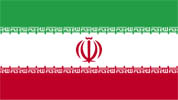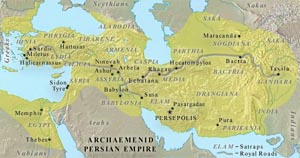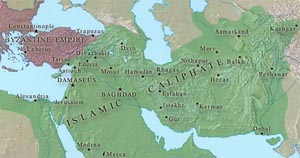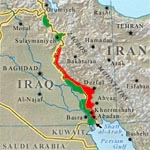|
<
Back to CORZAK
TEXT SOURCES:
CIA
World Factbook
The World Almanac - 2006
|
|
IRAN
|
|
| |

|
|
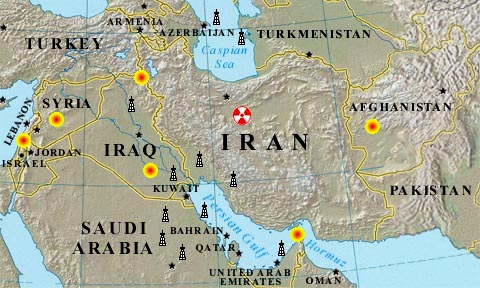 Click on map for News Flashes
Click on map for News Flashes |
INFORMATION CATEGORIES
|
Current
Overview
Today Iran occupies a highly strategic position between Iraq
and Afghanistan, two countries with American and allied
troops in active combat. It also overlooks the Persian Gulf,
through which much of the world's crude oil and natural gas moves. Sunni
Arab governments in the Gulf remain nervous about Shiite
Iran's growing influence. Current world attention focuses on Iran's
support of the Hezbollah militia in southern Lebanon
and Iran's apparent efforts to build nuclear weapons.
As of summer 2006, Iran faces Western pressure to halt its nuclear
activitiies as well as accusations of provoking Hezbollah to attack
Israel. The resulting war killed and wounded hundreds and caused billions
of dollars of damege.
Recent History
- 1908 - First Middle Eastern oil strike at Masjid-al-Salaman
in southwest Persia. Britain quickly seizes the rights to the oil
fields.
- 1935 - Changes name from Persia to Iran.
- 1941 - Britain & USSR invade Iran to stop pro-Nazi coup and
secure oil fields.
- 1951 to 1953 - Prime Minister Mossadegh nationalizes Iran's oil;
U.S. & British intelligence agencies overthrow him in coup.
- 1979 - Iranian Revolution. Ruling shah driven into exile; conservative
Shiite ayatollahs establish religious government.
- 1979 - Iranian students sieze U.S. Embassy and hold them as hostages
until 1981.
- 1980 to 1988 - Iran-Iraq War. Initiated by Iraq's Saddam Hussein,
war ends in stalemate with millions of casualties.
- 1997 to 2005 - President Khatami's political reforms fail. Iran's
population remains restive, with an increasingly young demographic,
restrictive social policies and poor economic performance.
- 2005 to 2006 - Conservative president Ahmadinejad takes power. Iran
uses increased oil revenue to fund diplomatic offensives.
|
 |
Geography |
|
LOCATION:
the Middle East, bordering the Gulf of Oman, the Persian Gulf and the
Caspian Sea, between Iraq, Afghanistan and Pakistan.
AREA:
636,296 million square miles.
BORDERS:
Afghanistan 936 km, Armenia 35 km, Azerbaijan-proper 432 km, Azerbaijan-Naxcivan
exclave 179 km, Iraq 1,458 km, Pakistan 909 km, Turkey 499 km, Turkmenistan
992 km
COASTLINE:
1,513 miles. Iran borders the Persian Gulf, the Gulf of Oman and the
Caspian Sea.
CLIMATE:
Mostly arid or semiarid; subtropical along Caspian coast.
TERRAIN: |
 |
|
Large salt deserts cover much
of the country (especially the eastern half) but there are many oases
and forest areas.. Rugged mountains rim a high, central basin with small,
discontinuous plains along both coasts. Most of Iran's population lives
in the north and nortwest (and has for thousands of years).
ELEVATION EXTREMES:
Lowest point: Caspian Sea at -92 ft.
Highest point: Qolleh-ye Damavand 18,601 ft.
NATURAL RESOURCES:
Petroleum, natural gas, coal, chromium, copper, iron ore, lead, manganese,
zinc; sulfur
LAND USE:
Urban Percentage 65%
Arable land: 10%
Permanent crops: 1%
Other: 24%
IRRIGATED LAND:
29,070 square miles.
NATURAL HAZARDS:
Earthquakes, periodic droughts, floods, dust storms; sandstorms.
ENVIRONMENTAL ISSUES:
Air pollution (especially in urban areas) from vehicle emissions, refinery
operations and industrial effluents; deforestation; overgrazing; desertification;
oil pollution in the Persian Gulf; wetland losses from drought and soil
degradation (salination); inadequate supplies of potable water; water
pollution from raw sewage and industrial waste; urbanization.
|
 |
People |
|
POPULATION:
68,688,433 (July 2006 est.)
AGE STRUCTURE: (2006 est.)
26.1% - 0-14 years (male 9,204,785; female 8,731,429)
69% - 15-64 years (male 24,133,919; female 23,245,255)
4.9% - 65 years and over (male 1,653,827; female 1,719,218)
MEDIAN AGE: (Definition)
24.8 years old
POPULATION GROWTH RATE:
1.1%
BIRTH RATE:
17 births per 1,000 population
DEATH RATE:
5.5 deaths per 1,000 population |
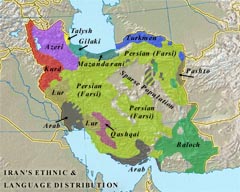 |
| Click
to enlarge |
NET EMIGRATION RATE: (Definition)
--0.48 emigrants per 1,000 population
INFANT MORTALITY RATE:
40 deaths per 1,000 live births
LIFE EXPECTANCY AT BIRTH:
Male: 69 years
Female: 72 years
TOTAL FERTILITY RATE:
1.9 children born per woman
ETHNIC GROUPS: (see map above)
Persian 51%, Azeri 24%, Gilaki and Mazandarani 8%, Kurd 7%, Arab 3%,
Lur 2%, Balochi 2%, Turkmen 2%, other 1%
RELIGIONS:
Shi'a Muslim 89%, Sunni Muslim 9%, Zoroastrian, Jewish, Christian and
Baha'i 2%
LANGUAGES: (see map above)
Persian (Farsi) and Persian dialects 58%, Turkic, Azeri and other Turkic
dialects 26%, Kurdish 9%, Luri 2%, Balochi 1%, Arabic 1%, Turkish 1%,
other 2%
LITERACY: (Definition)
Total population: 79.%
Male: 86%
Female: 73%
|
 |
Government |
|
COUNTRY NAME :
Long form: Islamic Republic of Iran
Short form: Iran
Former: Persia
Local form: Jomhuri-ye Eslami-ye Iran
GOVERNMENT TYPE:
Theocratic Republic
CAPITAL:
Tehran
ADMINISTRATIVE DIVISIONS:
28 provinces (ostanha): Ardabil, Azarbayjan-e Gharbi, Azarbayjan-e
Sharqi, Bushehr, Chahar Mahall va Bakhtiari, Esfahan, Fars, Gilan, Golestan,
Hamadan, Hormozgan, Ilam, Kerman, Kermanshah, Khorasan, Khuzestan, Kohgiluyeh
va Buyer Ahmad, Kordestan, Lorestan, Markazi, Mazandaran, Qazvin, Qom,
Semnan, Sistan va Baluchestan, Tehran, Yazd, Zanjan
|
|
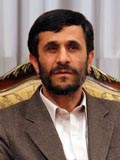 |
Mahmud Ahmadinejad,
President of Iran
Source: AP |
CONSTITUTION:
Drafted December 1979; revised 1989 to expand powers of the presidency
and eliminate the prime ministership.
LEGAL SYSTEM:
The Constitution codifies Islamic principles of government.
SUFFRAGE:
(Definition)
15 years of age, regardless of race, religion or sex (universal).
EXECUTIVE BRANCH:
Chief of State: Supreme Leader
Ayatollah Ali Hoseini-KHAMENEI. Appointed for life by the Assembly of
Experts as "Leader of the Islamic Revolution".
President
and Head of Government: Mahmud AHMADINEJAD elected by popular vote
for a four-year term. Election last held August 2005.
Cabinet:
Council of Ministers selected by the president with legislative approval;
the Supreme Leader has some control over appointments to the more sensitive
ministries.
First Vice President: Parviz DAVUDI (since
September 2005)
LEGISLATIVE BRANCH:
The Islamic Consultative Assembly or Majles-e-Shura-ye-Eslami has
one chamber with 290 seats. Members are elected by popular vote to serve
four-year terms. Last election held February 2004
Seats by party: Conservatives/Islamists 190, Reformers 50, Independents
43, Religious Minorities 5, and 2 seats unaccounted for
religious minorities 5
JUDICIAL BRANCH:
Supreme Court
MILITARY:
Iran has the regular Army, Navy and Air Force; the Revolutionary Guard
Corps (with its own Ground Force, Navy, Air Force and Special Forces)
and the Basij Militia.
ACTIVE TROOPS:
520,000 men (2004 est.)
MILITARY EXPENDITURES:
$4.3 billion, which is 3.3% of Iran's GDP.
DIPLOMATIC REPRESENTATION
WITH THE U.S.:
None. Iran has an Interests Section in the Pakistani Embassy in Washington,
and the protecting power for U.S. representation in Iran is Switzerland.
|
|
Economy |
|
ECONOMY - OVERVIEW:
Iran's economy is marked by a bloated, inefficient state sector, over
reliance on the oil sector, and government policies that create major
distortions throughout. Most economic activity is controlled by the
state. Private sector activity is typically small-scale - workshops,
farming, and services.
The current government has continued to follow the market reform plans
of previous governments, with limited progress. Relatively high oil
prices in recent years have enabled Iran to amass some $40 billion in
foreign exchange reserves, but have not eased economic hardships such
as high unemployment and inflation.
The proportion of the economy devoted to the development of weapons
of mass destruction remains a contentious issue with leading Western
nations.
GDP: (Definition)
$561.6 billion (2005 est.)
ranking - 21st in the world, highest in the Middle East
GDP GROWTH RATE:
6.1% (2005 est.)
GDP PER CAPITA: (Definition)
$8,300 (2005 est.)
ranking - 94th in the world, below world average of $9,500
|
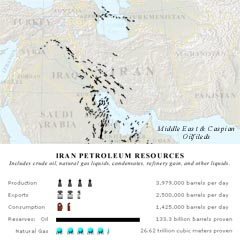 |
|
GDP - COMPOSITION BY SECTOR: (2005 est.)
agriculture: 11.6%
industry: 42.4%
services: 46%
POPULATION BELOW POVERTY LINE:
40%
UNEMPLOYMENT RATE:
11.2% (2004 est.)
BUDGET: (2005 est.)
Revenues: $48.82 billion
Expenditures: $60.4 billion; including capital expenditures
of $7.6 billion
INDUSTRIES:
petroleum, petrochemicals, textiles, cement and other construction materials,
food processing (particularly sugar refining and vegetable oil production),
metal fabrication, armaments
AGRICULTURAL PRODUCTS:
Wheat, rice, other grains, sugar beets, fruits, nuts, cotton; dairy
products, wool; caviar
ELECTRICITY PRODUCTION:
142.3 billion kilowatt hours (2003)
ELECTRICTY CONSUMPTION:
132.1 billion kilowatt hours (2003)
OIL PRODUCTION:
3.8 million barrels per day; 1.9 billion barrels per year
OIL EXPORTS:
2.2 million barrels per day; 803 billion barrels per year
OIL PROVEN RESERVES:
94.4 billion barrels
NATURAL GAS PRODUCTION:
79 billion cubic meters
NATURAL GAS PROVEN RESERVES: (2005)
26.62 trillion cubic meters
EXPORTS:
$55.42 billion. Commodities: petroleum (80%), chemical and petrochemical
products, fruits and nuts; carpets.
EXPORTS - PARTNERS:
Japan 17.3%, China 11.4%, Italy 6.2%, South Africa 5.5%, South Korea
5.2%, France 4.5%, Turkey 4.5%, Taiwan 4.3%, Netherlands 4.3%
IMPORTS:
$42.5 billion. Commodities: Industrial raw materials and intermediate
goods, capital goods, foodstuffs and other consumer goods, technical
services; military supplies.
IMPORTS - PARTNERS:
Germany 14.2%, China 8.3%, Italy 7.5%, UAE 6.7%, South Korea 6.4%, France
6.2%, Russia 5.3%
DEBT - EXTERNAL:
$19.06 billion
CURRENCY:
Iranian rial (IRR). There are 8,964 rials to the US dollar
(2005).
note: Iran has been using a managed floating exchange rate
regime since March 2002.
|
 |
Transportation & Communications
|
|
RAILWAYS:
4,465 miles 7256 km
HIGHWAYS:
103,637 miles. There are 684,500 passenger cars and 355,100 commercial
vehicles.
PIPELINES:
Gas and petroleum (crude and refined): 20,983 miles
condensate/gas 131 mi; gas 10,539 mi; liquid petroleum gas 353 mi; oil
5,119 mi; refined products 4,841 mi (2004)
PORTS AND HARBORS:
Main port: Bandar 'Abbas
Other ports: Abadan (largely destroyed during Iran-iraq War), Ahvaz,
Bandar-e Anzali, Bandar-e Bushehr, Bandar-e Emam Khomeyni, Bandar-e
Lengeh, Bandar-e Mahshahr, Bandar-e Torkaman, Chabahar (Bandar Beheshti),
Jazireh-ye Khark, Jazireh-ye Lavan, Jazireh-ye Sirri, Khorramshahr (limited
operation since November 1992).
AIRPORTS:
321 (129 paved) |
 |
Click
to enlarge |
TELEPHONE LINES IN USE:
14,571,100
TELEPHONE - MOBILE/CELLULAR:
4.3 million
RADIO STATIONS:
AM 72, FM 5; shortwave 5
TELEVISION STATIONS:
28 (plus 450 low-power repeaters)
INTERNET:
7.5 million users and 5,246 hosts. URL code is .ir
|
 |
History |
|
Iran was once called Persia. The Iranians, who supplanted
an earlier agricultural civilization, came from the northwest during
the 2nd millennium BC. They were an Indo-European
tribe related to the Aryans of India. Around 1000 BC, the Zoroastrian
religion was firmly established in ancient Persia and also
some of the neighboring countries.
In 549 BC Cyrus the Great united the Medes and Persians,
and as the the first shah (king), established the Archaemenid
Persian Empire (right top). He conquered Babylon
in 538 BC and restored Jerusalem to the Jews. He organized the empire,
built road and postal systems, established close but prudent overview
of his satraps (governors) and granted human rights to his
subjects. Egypt was added to the empire in 525 BC. Darius
the Great, (522-486 BC), through sound and farsighted administrative
planning, brilliant military maneuvering, and a humanistic worldview,
solidified the greatness of the Achaemenids, who, in less than thirty
years had raised the Iranians from an obscure tribe to a world power.
His son Xerxes (486-465 BC) after a number of failed
invasions of classical Greece sank into self-indulgence and the decline
of the empire began.
Alexander the Great conquered Persia in 333 BC, but
Persia regained independence in the next century under the Parthians,
the enemy of Rome. The Parthians themselves were overthrown by the
Sassanid Persians in 226 AD (right center).
For the next 400 years the SassanIans and the Roman/Byzantines fought
off and on for control of the Near East.
Arabs brought Islam to Persia in 636 AD, replacing
the indigenous Zoroastrian faith (right bottom).
Persia remains Islamic to this day. After Persian political and cultural
autonomy was reasserted in the 800s AD, the arts and sciences flourished.
Turks and Mongols dominated Persia in turn from 1044 to 1502 AD, when
Ismael I established the Iranian Safavid Dynasty,
and made the Shiite Islam the official religion.
The dynasty lasted until 1722. Persia stabilized under the Qajar Dynasty,
ruling from 1779 to 1925, but by this time the country could not hope
to compete with the new industrial powers of Europe. Persia found
itself sandwiched between the growing Russian Empire
in Central Asia and the expanding British Empire
in India. Afghanistan was severed from Iran by Britain in 1857.
Although Persia was never directly invaded, it was made economically
dependent on Europe. Britain and Russia each created a sphere of influence
in which the colonial power had the final say on economic matters.
So, when the first Middle Eastern oil strike was
made in 1908 at Masjid-al-Salaman in southwest Persia, Britain quickly
took up the rights to the oil finds. Persian oil became one of the
major commodities to flow into Britain
During World War I, Persian territory was violated by both Britain
and Russia. After the war and the Russian Revolution, Britain claimed
Persia as a protectorate and took tighter control over the increasingly
lucrative oilfields.
|
|
Click
to enlarge
|
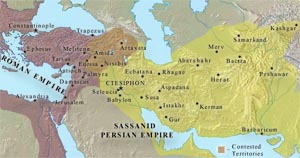 |
Click
to enlarge
|
| |
Click
to enlarge
|
In 1925, Reza Khan Pahlavi, a military officer, seized power from
the Qajars and declared himself first shah of the Pahlavi
Dynasty. He began modernization, curbed foreign influence,
and officially changed the country's name from Persia to Iran
in 1935.
During World War II, Britain and the USSR invaded Iran from August
25 to September 17, 1941, to stop an Axis-supported coup and secure
Iran's petroleum infrastructure. The Allies of World War II forced
the shah to abdicate in favor of his son, Mohammad Reza Pahlavi,
whom they hoped would be more supportive. In 1951, an eccentric pro-democratic
nationalist, Dr. Mohammed Mossadegh rose to prominence
in Iran and was elected its first Prime Minister. As Prime Minister,
Mossadegh alarmed the West by his nationalization of Anglo-Iranian
Oil Company (later renamed BP), which controlled all of the country's
oil reserves. Britain immediately put an embargo on Iran. Members
of the British Intelligence Service approached the United States under
President Eisenhower in 1953 to join them in Operation Ajax, a coup
against Mossadegh. President Eisenhower agreed, and authorized the
CIA to assist the BIS in overthrowing Mossadegh. The Shah at first
attempted to formally dismiss Mossadegh, but this backfired and Mossadegh
convinced the Shah to flee to Baghdad.
During the Cold War, the U.S. and the Soviet Union engaged in diplomatic
and economic sparring in the highly strategic Iran. With U.S. backing,
the shah introduced economic and social changes to Iran -- the "White
Revolution" --but repression, often severe, of the conservative
Islamic opposition intensified. Violent protests in 1978 eventually
forced the shah to depart on Jan 16, 1979. He appointed Prime Minister
Bakhtiar to head a regency council in his absence.
Shiite leader Ayatollah Ruhollah Khomeini, exiled
by the shah in 1963, returned to Tehran on Feb. 1 and by Feb. 11 pro-Khomeini
forces had completely defeated government troops. Khomeini established
an Islamic theocracy, and many Iranians associated with the Shah's
government went into exile.
Iranian militants seized the U.S. embassy in Nov. 1979 and took hostages
including 62 Americans. Despite international condemnation and U.S.
efforts, including an abortive Apr. 1990 rescue attempt, the crisi
continued. The U.S. broke off diplomatic relations with Iran on Apr.
7, 1990. The former shah died in Egypt in July 1990. The hostage drama
ended on Jan. 20, 1981 when an accord, involving the release of frozen
Iranian financial assets, was reached.
|
A dispute over the Shatt al-Arab waterway situated
between Iran and Iraq led to a long and costly war
(right) between the two countries, beginning on
Sept. 22, 1980. Iraqi troops occupied Iranian territory, including
the port city of Khorramshahr in October. Iranian troops recaptured
the city and drove Iraqi troops back across the border in May 1982.
In Nov. 1986 it became known that the U.S., which had generally sided
with Iraq during the war, had secretly shipped arms to Iran to gain
that country's help in obtaining the release of U.S. hostages held
by terrorists in Lebanon. The revelation sparked a major scandal in
the Reagan administration. In July 1988, a U.S. Navy warship shot
down an Iranian commercial airliner, mistaking it for an F-15 fighter
jet. All 290 aboard the plane died.
In Aug. 1988, Iran agrred to accept a UN resolution calling for a
cease-fire with Iraq. The war had been disasterous for both countries,
with casualties ranging from 500,000 to 1 million dead, 1-2 million
wounded, and more than 80,000 prisoners. Many Iranians suffered terribly
from Iraqi chemical weapons.
|
|
Click
to Enlarge
|
In earthquake struck northern Iran in June 1990, causing more than
145,000 killed or wounded and leaving 400,000 homeless. Some one million
Kurdish refugees fled from Iraq to Iran in 1991 following the Persian
Gulf War. In 1996, to curb Iran's alleged support for international
terrorism, the U.S. authorized sanctions on all foriegn companies
investing there.
Mohammad Khatami, a moderate Shiite Muslim cleric, was elected president
in May 1997. He won nearly 70% of the vote by promising to reform
the religious government. During the next 3 years, hardline Islamists
clashed repeatedly and sometimes violently with the reformers, who
won a majority in parlimentary elections in 2000. To inspire the reformers
and invite rapprochement with Iran, the U.S. eased some sanctions.
Khatami was reelected in 2001, with a 77% majority. Today Khatami
continues to face resistance from Supreme Leader Ayatollah Khamenei
and the religious conservatives.
The U.S.-led war in Iraq, beginning in Mar. 2003, contributed to a
new period of tension between Iran and the U.S.as Iran works to increase
its influence among the Shiite majority in southern Iraq. But while
the Iranian reformers want peaceful relations with new the Iraqi interim
government, the religious conservatives continue to send arms and
money to radical Shiite militants, apparently hoping to set up a Shiite
theocracy in Iraq in mirror image of Iran.
U.S.-Iran relations are also clouded by Iran's apparent attempts to
develop nuclear weapons, and suspicions that they are sheltering some
high-ranking al-Qaeda members.
In June 2004, armed Islamist vigilantes harassed reformist students
who were holding pro-democracy protests in Tehran and other cities.
In April 2005, there was unrest among Iran's Arab minority in the
southwest over government efforts to control Arab language press.
Back to Top
Corey Zak - CORZAK.COM
|
| |
|
|
|
|
|
|
|
|
|







